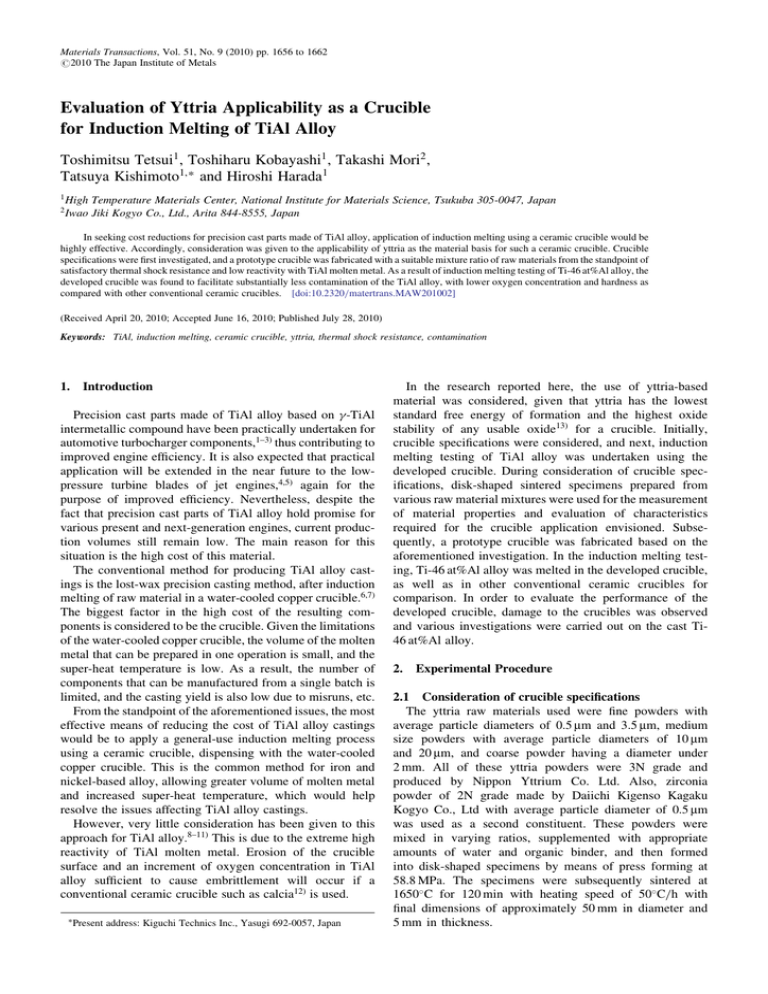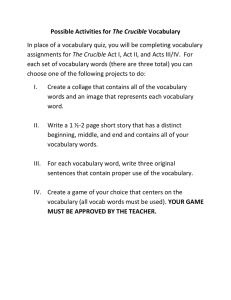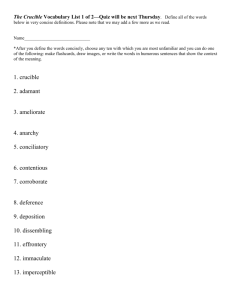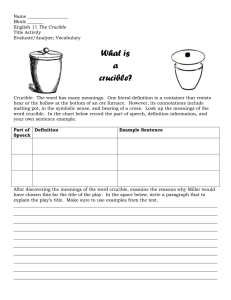Evaluation of Yttria Applicability as a Crucible for Induction Melting
advertisement

Materials Transactions, Vol. 51, No. 9 (2010) pp. 1656 to 1662 #2010 The Japan Institute of Metals Evaluation of Yttria Applicability as a Crucible for Induction Melting of TiAl Alloy Toshimitsu Tetsui1 , Toshiharu Kobayashi1 , Takashi Mori2 , Tatsuya Kishimoto1; * and Hiroshi Harada1 1 2 High Temperature Materials Center, National Institute for Materials Science, Tsukuba 305-0047, Japan Iwao Jiki Kogyo Co., Ltd., Arita 844-8555, Japan In seeking cost reductions for precision cast parts made of TiAl alloy, application of induction melting using a ceramic crucible would be highly effective. Accordingly, consideration was given to the applicability of yttria as the material basis for such a ceramic crucible. Crucible specifications were first investigated, and a prototype crucible was fabricated with a suitable mixture ratio of raw materials from the standpoint of satisfactory thermal shock resistance and low reactivity with TiAl molten metal. As a result of induction melting testing of Ti-46 at%Al alloy, the developed crucible was found to facilitate substantially less contamination of the TiAl alloy, with lower oxygen concentration and hardness as compared with other conventional ceramic crucibles. [doi:10.2320/matertrans.MAW201002] (Received April 20, 2010; Accepted June 16, 2010; Published July 28, 2010) Keywords: TiAl, induction melting, ceramic crucible, yttria, thermal shock resistance, contamination 1. Introduction Precision cast parts made of TiAl alloy based on -TiAl intermetallic compound have been practically undertaken for automotive turbocharger components,1–3) thus contributing to improved engine efficiency. It is also expected that practical application will be extended in the near future to the lowpressure turbine blades of jet engines,4,5) again for the purpose of improved efficiency. Nevertheless, despite the fact that precision cast parts of TiAl alloy hold promise for various present and next-generation engines, current production volumes still remain low. The main reason for this situation is the high cost of this material. The conventional method for producing TiAl alloy castings is the lost-wax precision casting method, after induction melting of raw material in a water-cooled copper crucible.6,7) The biggest factor in the high cost of the resulting components is considered to be the crucible. Given the limitations of the water-cooled copper crucible, the volume of the molten metal that can be prepared in one operation is small, and the super-heat temperature is low. As a result, the number of components that can be manufactured from a single batch is limited, and the casting yield is also low due to misruns, etc. From the standpoint of the aforementioned issues, the most effective means of reducing the cost of TiAl alloy castings would be to apply a general-use induction melting process using a ceramic crucible, dispensing with the water-cooled copper crucible. This is the common method for iron and nickel-based alloy, allowing greater volume of molten metal and increased super-heat temperature, which would help resolve the issues affecting TiAl alloy castings. However, very little consideration has been given to this approach for TiAl alloy.8–11) This is due to the extreme high reactivity of TiAl molten metal. Erosion of the crucible surface and an increment of oxygen concentration in TiAl alloy sufficient to cause embrittlement will occur if a conventional ceramic crucible such as calcia12) is used. *Present address: Kiguchi Technics Inc., Yasugi 692-0057, Japan In the research reported here, the use of yttria-based material was considered, given that yttria has the lowest standard free energy of formation and the highest oxide stability of any usable oxide13) for a crucible. Initially, crucible specifications were considered, and next, induction melting testing of TiAl alloy was undertaken using the developed crucible. During consideration of crucible specifications, disk-shaped sintered specimens prepared from various raw material mixtures were used for the measurement of material properties and evaluation of characteristics required for the crucible application envisioned. Subsequently, a prototype crucible was fabricated based on the aforementioned investigation. In the induction melting testing, Ti-46 at%Al alloy was melted in the developed crucible, as well as in other conventional ceramic crucibles for comparison. In order to evaluate the performance of the developed crucible, damage to the crucibles was observed and various investigations were carried out on the cast Ti46 at%Al alloy. 2. Experimental Procedure 2.1 Consideration of crucible specifications The yttria raw materials used were fine powders with average particle diameters of 0.5 mm and 3.5 mm, medium size powders with average particle diameters of 10 mm and 20 mm, and coarse powder having a diameter under 2 mm. All of these yttria powders were 3N grade and produced by Nippon Yttrium Co. Ltd. Also, zirconia powder of 2N grade made by Daiichi Kigenso Kagaku Kogyo Co., Ltd with average particle diameter of 0.5 mm was used as a second constituent. These powders were mixed in varying ratios, supplemented with appropriate amounts of water and organic binder, and then formed into disk-shaped specimens by means of press forming at 58.8 MPa. The specimens were subsequently sintered at 1650 C for 120 min with heating speed of 50 C/h with final dimensions of approximately 50 mm in diameter and 5 mm in thickness. Evaluation of Yttria Applicability as a Crucible for Induction Melting of TiAl Alloy TIG welding torch TiAl molten metal Cross sectional observation Sintered specimen Backing (TiAl) Fig. 1 Schematic illustration for evaluation method of reactivity between sintered specimen and TiAl molten metal using TIG welding, and example of cross-sectional macrostructure of re-melted TiAl alloy. These various sintered specimens were used for measurement of material properties and evaluation of the characteristics required for the crucible application. The material properties assessed were porosity according to JIS R 2205, central pore diameter by means of mercury porosimetry, and flexural strength by three-point bending testing using a specimen having cross section of 3 4 mm and chamfered corner of C0.2 mm and whose surface was ground by #800 emery paper. One test measurement was conducted for each of the sample conditions. Characteristics evaluated with respect to the crucible application were resistance to thermal shock and reactivity with TiAl molten metal. In order to evaluate resistance to thermal shock, water quenching testing was employed repeatedly from temperatures of 1000 to 1300 C. In considering reactivity with TiAl molten metal, simple melting testing was conducted as presented in Fig. 1 using TIG welding. A hole of approximately 5 mm was formed in the center of the specimens and TIG welding was applied for re-melting of TiAl alloy in this hole. Melting time was constant at 20 s. After cooling, the cross-sectional microstructure of the re-melted TiAl alloy was observed using an optical microscope in order to assess the state of material mixing between the specimens and the TiAl molten metal and the area ratio of inclusions in TiAl alloy was measured by image processing of optical microscope images. Results and Discussion 3.1 Consideration of crucible specifications Concerning the relationships between the raw material mixture ratio and the material properties of the sintered specimens, the relationship between the ratio of coarse yttria powder and porosity, center pore diameter and flexural strength without zirconia are shown in Fig. 2. An increased ratio of coarse powder is accompanied by lower flexural strength. It is thought that bonding between particles by sintering becomes insufficient when the ratio of coarse powder increases. No clear trend is seen with respect to porosity and central pore diameter. Figure 3 shows the relationships between the ratio of zirconia addition and the material properties. The ratio of coarse yttria powder is constant at 25 mass%. Porosity reaches a minimum at a zirconia addition of around 20 mass%. Maximum flexural strength is at a zirconia addition of around 5 mass%, and is seen to decrease at 30 mass% and over. Enhanced sintering due to the suitable amount of zirconia addition is thought to be a cause of these two behaviors. Central pore diameter does 30 25 0 20 40 60 80 Ratio of Coarse Powder (%) 100 (c) 8 Flexural Strength, σ /MPa Center Pore Diameter, D/µm (b) 35 Porosity (%) 3. 20 (a) 20 2.2 Induction melting testing of TiAl alloy An yttria-based crucible manufactured based on the abovementioned investigation and other reference crucibles (namely calcia, zirconia, and alumina) were used for induction melting testing of TiAl alloy. The dimensions of these crucibles were approximately 50 mm in outer diameter, 40 mm in inner diameter, and 100 mm in height. The composition of the alloy was Ti-46 at%Al, in the amount of approximately 150 g, with the raw materials consisting of sponge titanium of 3N grade made by Toho Titanium Co., Ltd and aluminum pellets of 4N grade made by Furuuchi Chemical Corp. The melting atmosphere was Ar 5:3 104 Pa. After melting of the entire raw material, the molten metal was held for 1 min and then poured into molds of cast iron measuring 30 mm in diameter. Evaluation consisted of inspection of the state of damage for the crucibles and evaluation of the cast TiAl alloy. The latter included chemical analysis of oxygen concentration, Vickers hardness measurement, and microstructural observation using optical and scanning electron microscopes. Elemental analysis of inclusions was also performed by means of EDX. 10 40 1657 6 4 2 0 0 20 40 60 80 Ratio of Coarse Powder (%) 100 15 10 5 0 0 20 40 60 80 100 Ratio of Coarse Powder (%) Fig. 2 Relationship between ratio of coarse powder and properties of sintered sample without zirconia. (a) Porosity, (b) center pore diameter, (c) flexural strength. 1658 T. Tetsui, T. Kobayashi, T. Mori, T. Kishimoto and H. Harada 40 10 20 (a) 30 25 0 10 20 30 40 8 6 4 2 0 50 Ratio of Zirconia Addition (%) Flexural Strength, σ /MPa Center Pore Diameter, D /µm Porosity (%) 35 20 (c) (b) 0 10 20 30 40 50 15 10 5 0 0 10 Ratio of Zirconia Addition (%) 20 30 40 50 Ratio of Zirconia Addition (%) Fig. 3 Relationship between ratio of zirconia addition and properties of sintered sample, the ratio of coarse powder is constant at 25 mass%. (a) Porosity, (b) center pore diameter, (c) flexural strength. (a) (b) (c) Fig. 4 Examples of the thermal shock test results. (a) 25 mass% coarse powder sample after 1 cycle of water quenching from 1200 C, (b) 75 mass% coarse powder sample after 5 cycles of water quenching from 1300 C, (c) 25 mass% coarse powder and 10 mass% zirconia sample after 5 cycles of water quenching from 1300 C. not exhibit any clear trend with respect to the amount of zirconia. Turning to the characteristics required for the crucible application envisioned, Fig. 4 shows examples of the thermal shock test results. Cracking and exfoliation were observed after one cycle of water quenching from 1200 C for the specimen containing 25 mass% coarse powder. The specimen containing 75 mass% coarse powder remained sound through four cycles of water quenching from 1300 C, but disintegrated completely upon the fifth cycle. The specimen containing 25 mass% coarse powder and zirconia addition of 10 mass% remained sound even after five cycles of water quenching from 1300 C. Figure 5 indicates examples of the test results for reactivity between sintered samples and TiAl molten metal using TIG welding. The specimen containing 25 mass% coarse powder was subject to comparatively shallow invasion of TiAl alloy, with almost no mixing of material from the sintered specimen into the TiAl alloy. Conversely, the specimen containing 75 mass% coarse powder shows deep invasion of the TiAl alloy and numerous inclusions are observed in the TiAl alloy. The result is essentially the same for the specimen containing 25 mass% coarse powder with 10 mass% addition of zirconia, although there are somewhat fewer inclusions. Figure 6 summarizes the relationship between the raw material mixture ratio and the characteristics for the crucible application, (a) without zirconia, (b) with zirconia. On the vertical axis 6 represents the best characteristics and 0 the worst in terms of relative comparison, and the relationship between each index number and the characteristics for the crucible application are shown in Table 1. Although thermal shock resistance improves with a higher ratio of coarse powder, reactivity resistance tends to decrease. Similarly, greater zirconia addition also tends to improve resistance to thermal shock, while reducing resistance to reactivity. Figure 7 summarizes the relationship between the material properties of the sintered specimens and the characteristics for the crucible application. Lower porosity is accompanied by greater thermal shock resistance, but with no particularly noticeable effect on reactivity resistance. Greater flexural strength is accompanied by greater resistance to reactivity, but with little effect on resistance to thermal shock. Let us consider then, what these results mean for improving the performance of an yttria-based crucible to be used in induction melting of TiAl alloy. Better thermal shock resistance can be achieved by increasing the ratio of coarse powder and by adding zirconia. Reduced porosity is also effective. On the other hand, a lower ratio of coarse powder and no zirconia addition are found to improve reactivity resistance. Improvement of strength is also effective. In other words, improved resistance to thermal shock and reactivity appear to be conflicting requirements, difficult to simultaneously realize. Evaluation of Yttria Applicability as a Crucible for Induction Melting of TiAl Alloy Boundary of sintered specimen and TiAl alloy 1659 Center of TiAl alloy (a) (b) (c) Fig. 5 Examples of the test result of reactivity between sintered sample and TiAl molten metal by means of TIG welding. (a) 25 mass% coarse powder, (b) 75 mass% coarse powder, (c) 25 mass% coarse powder and 10 mass% zirconia addition. Thermal Shock Resistance Reactivity Resistance 6 3 2 1 0 3 2 1 0 0 20 40 60 80 Ratio of Coarse Powder (%) 100 5 4 Relative Properties Relative Properties 4 (b) Good 5 0 20 40 60 80 100 Ratio of Zirconia Addition (%) 3 2 1 0 20 5 4 Relative Properties 4 6 (a) Good Good Good 5 Thermal Shock Resistance Reactivity Resistance 6 (b) (a) Relative Properties Thermal Shock Resistance Reactivity Resistance Thermal Shock Resistance Reactivity Resistance 6 25 30 Porosity (%) 35 40 3 2 1 0 0 5 10 15 20 Flexural Strength, σ /MPa Fig. 6 Relationship between the mixture ratio of raw material and characteristics which required for the crucible application. (a) Ratio of coarse powder without zirconia, (b) ratio of zirconia addition (the ratio of coarse powder is constant at 25 mass%). Fig. 7 Relationship between the properties of sintered sample and characteristics which required for the crucible application. (a) Porosity, (b) flexural strength. The specifications of the crucible to be used in induction melting testing of TiAl alloy were thus determined from the following perspective: First, as the intended purpose of this work was to reduce the reactivity of a ceramic crucible with TiAl molten metal, it was decided not to add zirconia. Nevertheless, given that a crucible overly susceptible to thermal shock cracking would be broken during the heating process and would therefore be impractical, the raw material mixture ratio was selected to provide an acceptable level of resistance to thermal shock. Figure 8 presents an external 1660 T. Tetsui, T. Kobayashi, T. Mori, T. Kishimoto and H. Harada Table 1 Relationship between each index number and the characteristics for the crucible application in Fig. 6 and Fig. 7. Thermal shock resistance Reactivity resistance Index Conditions that samples number were broken after water quenching testing 0 From 1000 C More than 5% 1 From 1100 C 35% 2 From 1200 C Area ratio of inclusions in TiAl alloy 23% 3 One cycle from 1300 C 12% 4 Two or three cycles from 1300 C 0:51% 5 Four or five cycles from 1300 C 0:10:5% 6 Remained sound after five cycles from 1300 C Less than 0.1% Fig. 8 (a) (b) (c) An external view of the developed yttria crucible. (d) Fig. 9 External appearances of each of the crucibles after melting testing of Ti-46 at%Al alloy. (a) yttria, (b) calcia, (c) zirconia, (d) alumina. view of the developed yttria crucible fabricated with these considerations in mind. The ratio of coarse powder was 30 mass%, with forming pressure and sintering conditions being the same as for the disk-shaped specimens. 3.2 Induction melting testing of TiAl alloy Figure 9 shows the external appearances of each of the crucibles after melting testing of Ti-46 at%Al alloy. No cracking is seen for any of the crucibles. Given that the developed yttria crucible is sound at this point, it is concluded that a certain measure of thermal shock resistance has been achieved, as per the intent. Figure 10 presents the external appearance of the Ti46 at%Al alloy after casting. Table 2 indicates the concentration of oxygen of Ti-46 at% alloys melted in each of the crucibles, as well as Vickers hardness. With respect to the concentration of oxygen, the amount corresponding to the developed yttria crucible represents the lowest level by far (about 1/6 that for the calcia crucible, 1/8 that for the Fig. 10 External appearance of the Ti-46 at%Al alloy after casting. Evaluation of Yttria Applicability as a Crucible for Induction Melting of TiAl Alloy Table 2 Concentration of oxygen and Vickers hardness of Ti-46 at%Al alloys melted in each crucible. Crucible Concentration of oxygen (mass%) Vickers hardness (Hv) Yttria 0.12 293 Calcia 0.71 352 Zirconia 0.96 401 Alumina 1.57 407 zirconia crucible, and 1/13 that for the alumina crucible). Because the oxygen concentration of the metallic raw material is about 0.04 mass%, the majority of this oxygen might come from the crucible, and the reason for the abovenoted difference is considered to be the difference in oxide stability for each of the crucibles. Vickers hardness is correlated with oxygen concentration, such that the Ti46 at%Al alloy from the developed yttria crucible also resulted in the lowest hardness. Thus, it was clarified that contamination of the TiAl alloy melted in the developed yttria crucible is extremely low in comparison with the other conventional crucibles. Figure 11 shows the optical microstructures for the Ti46 at%Al alloy melted in each of the crucibles. Inclusions can be seen in each case, with the greatest inclusion size observed in the alloy melted in the alumina crucible. There was no appreciable difference in size among the others. In terms of the amount of inclusions, the zirconia crucible resulted in the least, increasing in the order of developed yttria and then calcia. Figure 12 shows back-scattered electron images for the Ti-46 at%Al alloy melted in each of the crucibles (except for alumina), together with EDX analysis results for the 1661 inclusions. The inclusions in the alloy melted in the developed yttria crucible are almost exclusively composed of Y and O, considered to be separated yttria powder, as it is from the crucible. In the cases of the alloys melted in the calcia and zirconia crucibles, substantial Ti and Al are found to be present in the inclusions. This means that the separated calcia and zirconia powder from the crucible have reacted with the TiAl molten metal. The reason why inclusions in the alloys melted in the zirconia crucible were seen to be fewer in the optical microstructure is thought to be that most of the zirconia powder separated from the crucible was melted into TiAl alloy. From the foregoing results, it was clarified that the contamination of the TiAl alloy was greatly reduced by the developed yttria crucible, as compared with other conventional crucibles. The main factor involved here is considered to be the oxide stability of yttria compared to the other crucible materials, resulting in less reaction with the TiAl molten metal. However, as indicated in Table 2 and Fig. 11, the concentration of oxygen was 0.12 mass%, a comparatively high level, and there was a certain amount of inclusions with respect to the Ti-46 at% alloy melted in the developed yttria crucible. These levels need to be reduced in the future. Since these inclusions are considered to be yttria powder itself separated from the crucible, the prevention of such exfoliation is the main issue with which to be dealt. One approach would be to increase the strength by using a lower ratio of coarse powder, although this would negatively affect thermal shock resistance as noted in Fig. 7. Accordingly, in using a higher strength crucible, careful operation such as minimizing the heating and cooling speed would be required in order to avoid cracking. (a) (b) (c) (d) Fig. 11 Optical microstructures for the Ti-46 at%Al alloy melted in each of the crucibles. (a) yttria, (b) calcia, (c) zirconia, (d) alumina 1662 T. Tetsui, T. Kobayashi, T. Mori, T. Kishimoto and H. Harada Back scattered electron image EDX analysis results (a) (b) (c) Fig. 12 Back-scattered electron images and EDX analysis results for the Ti-46 at%Al alloy melted in each of the crucibles. (a) yttria, (b) calcia, (c) zirconia. 4. Conclusion Applicability of yttria-based material for a crucible to be used in induction melting of TiAl alloy was evaluated. Conclusions were obtained as follows: (1) An increased ratio of coarse powder, zirconia addition, and reduced porosity were effective with respect to increased resistance to thermal shock. Conversely, however, a reduced ratio of coarse powder, lack of zirconia addition, and greater strength were effective for improved resistance to reactivity with TiAl molten metal. It is therefore difficult to simultaneously achieve both of these desired characteristics required for the crucible application. (2) The oxygen concentration and hardness of the Ti46 at%Al alloy melted in the developed yttria crucible were noticeably lower than for the other conventional crucibles such as calcia, zirconia and alumina. (3) However, the exfoliation and mixing into the TiAl alloy of yttria powder itself from the crucible was observed, and future work should focus on the prevention of this behavior. REFERENCES 1) 2) 3) 4) 5) 6) 7) 8) 9) 10) 11) 12) 13) T. Tetsui and S. Ono: Intermetallics 7 (1999) 689–697. T. Tetsui: Adv. Eng. Mater. 3 (2001) 307–310. T. Tetsui: Mater. Sci. Eng. A 329–331 (2002) 582–588. T. Fujimura, H. Nishikawa, N. Moriya and M. Imamura: IHI Gihou 48 (2008-9) 153–158. M. Weimer and T. Kelly: Structural Aluminides for Elevated Temperatures, Gamma Titanium and Other Metallic Aluminides, (TMS, Warrendale, 2008) pp. 5–6. T. Noda: Intermetallics 6 (1998) 709–713. D. E. Larsen: Mater. Sci. Eng. A 213 (1996) 128–133. F. Gomes, J. Barbosa and C. S. Ribeiro: Intermetallics 16 (2008) 1292– 1297. J. P. Kuang, R. A. Harding and J. Campbell: Int. J. Cast. Metals Res. 13 (2001) 277–292. J. Barbosa and C. S. Ribeiro: Int. J. Cast. Metals Res. 12 (2000) 293– 301. J. P. Kuang, R. A. Harding and J. Campbell: Mater. Sci. Technol. 16 (2000) 1007–1016. N. Sakuma, T. Mitsui, H. Kurabe and T. Tsuijimoto: Tetsu-to-Hagane 78 (1992) 172–179. I. Barin: Thermochemical data of pure substances, (VCH-Verlag, Weinheim, 1989).




